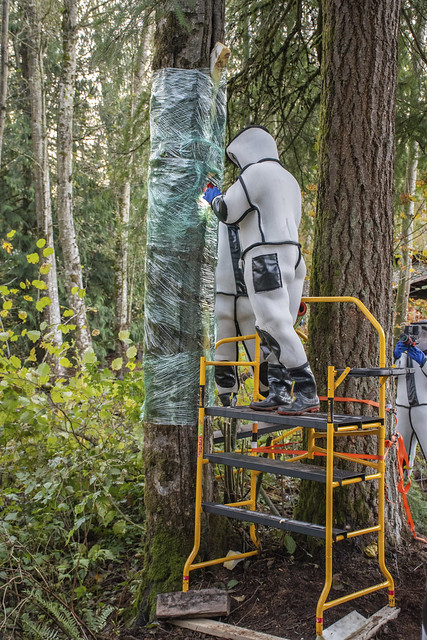
They’re still here … and perhaps more widespread than thought last year. What officials have learned is that colonies are often high up in trees, not in the ground, as expected based on behavior in Asia. This makes detection and control especially difficult.
In June a citizen found a dead Asian giant hornet (AGH) male in Snohomish County. This county in the Seattle metropolitan area is separated from Whatcom County (site of last year’s detections) by a third county, Skagit County. The Washington State Department of Agriculture (WSDA) responded by setting up traps in Snohomish and King counties, and urging citizens to be alert and report any hornet sightings.
Equally worrying, the dead wasp was determined by appearance and genetics to be unrelated to the colonies detected in 2019 and 2020 in Washington and British Columbia. Trapping in the areas found no additional specimens (S. Spichiger pers. comm.)
In July, WSDA designated the hornet genus Vespa as a quarantine pest; this action confirms WSDA authority to control access to nest sites.
Nests Found and Destroyed
Starting in late summer, citizens began reporting sightings and officials succeeded in tracking hornets to their nests. However, it was not easy! Eradicating Asian giant hornets demands lots of resources and commitment. While all these nests were in Whatcom County – site of last year’s detections — it is clear that several colonies had been established. It seems to me highly unlikely that they have all been detected.
Detection of the first nest in 2021 came in August, following several visual detections of the hornets attacking nests of paper wasps. WSDA staff captured and tagged three hornets over a couple of days. They succeeded in tracking the third hornet when it reappeared a week later. The nest was destroyed (after removal of all hornets) on August 25th. This nest held nine layers of comb with 292 eggs, 422 larvae, and 563 prepuae. Nearly 200 adult hornets were killed. One queen was found. [Hornet Herald 21.07 Sept. 8 2021] The nest was at the base of a dead alder tree in rural Whatcom County, east of Blaine, just 400 metres south of the Canadian border.
The second and third nests were detected on September 8 and 10, 2021. In these cases, tagging and tracking the hornets was easier than in August. Nest eradication was not easy, however. Both nests were high inside dead alder trees, making access difficult. Both nests held multiple combs with hundreds of larvae, eggs, and pupae. Fortunately, only one queen was found in each. [Hornet Herald 21.08; October 5, 2021]
No detections have occurred since these.
WSDA also collected data on foraging behaviors of wasps in the third nest. Data include information on periods during the day when the wasps are active, and what materials they bring back to the nest – which includes wood pulp for nest comb construction and insect thoraces for feeding the pupae. [Hornet Herald 21.08; October 5, 2021]
It is encouraging that only one queen was found in each nest; in 2020, the single nest officials destroyed held 200 queens!
Trapping in British Columbia
Although British Columbia officials increased the number of traps in 2021, and urged citizens to also set out traps, no confirmed AGH finds were made in British Columbia until early November, when one was caught in a trap set for Japanese beetles. This hornet was on the border with Washington, so officials are trying to determine whether it came from one of the nests already discovered there.
There were a couple of unconfirmed sightings. On October 22 a single, aged specimen was found in a Japanese beetle trap about 1.2 km north of the first hornet nest extracted this year in Washington. The beetle trap had been serviced one month earlier. Canadian government entomologists are analyzing the DNA of this specimen to see if it was related to the Washington State nests.
At least one citizen said he had seen an Asian giant hornet in July, but officials said they could not investigate until they had either a picture or a specimen.

Intriguing wrinkle
Mattila et al. (2021) describe an “impressive array of strategies” Asian honey bees use to protect nests from attacks by hornets in the genus Vespa, including a previously unknown use of auditory and perhaps chemical signals to warn nest mates. The authors suggest that this diverse alarm repertoire is similar to alarms issued by socially complex vertebrates such as primates and birds.
SOURCES OF INFORMATION
USDA Agriculture Research Service: https://scientificdiscoveries.ars.usda.gov/highlights/asian-giant-hornet/
Washington State Department of Agriculture https://agr.wa.gov/hornets
Mattila, H.R., H.G. Kernen, G.W. Otis, L.T.P. Nguyen, H.E. Pham, O.M. Knight, N.T. Phan. 2021.
Giant hornet (Vespa soror) attacks trigger frenetic antipredator signalling in honeybee (Apis cerana) colonies. R. Soc. Open Sci. 8: 211215. https://doi.org/10.1098/rsos.211215
Posted by Faith Campbell
We welcome comments that supplement or correct factual information, suggest new approaches, or promote thoughtful consideration. We post comments that disagree with us — but not those we judge to be not civil or inflammatory.
For a detailed discussion of the policies and practices that have allowed tree-killing pests to enter and spread – and that do not promote effective restoration strategies – review the Fading Forests report at http://treeimprovement.utk.edu/FadingForests.htm
